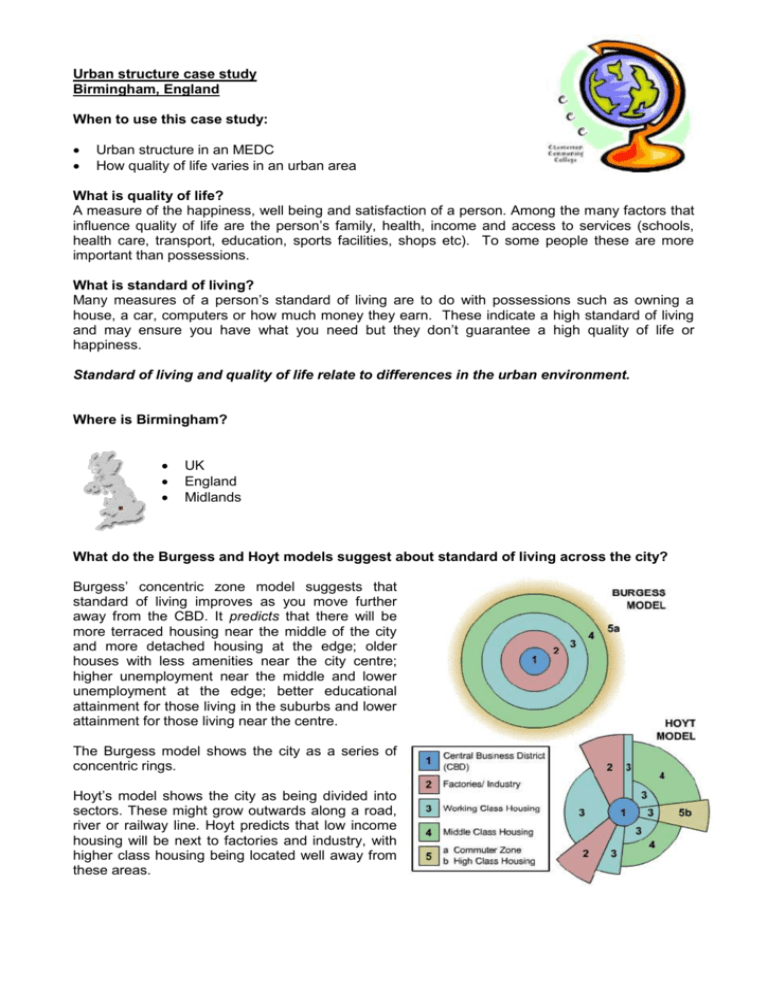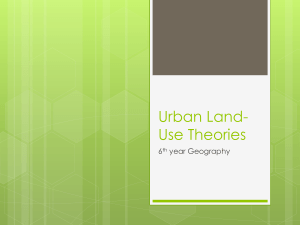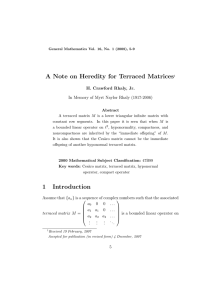birmingham-urban-structure-case
advertisement

Urban structure case study Birmingham, England When to use this case study: Urban structure in an MEDC How quality of life varies in an urban area What is quality of life? A measure of the happiness, well being and satisfaction of a person. Among the many factors that influence quality of life are the person’s family, health, income and access to services (schools, health care, transport, education, sports facilities, shops etc). To some people these are more important than possessions. What is standard of living? Many measures of a person’s standard of living are to do with possessions such as owning a house, a car, computers or how much money they earn. These indicate a high standard of living and may ensure you have what you need but they don’t guarantee a high quality of life or happiness. Standard of living and quality of life relate to differences in the urban environment. Where is Birmingham? UK England Midlands What do the Burgess and Hoyt models suggest about standard of living across the city? Burgess’ concentric zone model suggests that standard of living improves as you move further away from the CBD. It predicts that there will be more terraced housing near the middle of the city and more detached housing at the edge; older houses with less amenities near the city centre; higher unemployment near the middle and lower unemployment at the edge; better educational attainment for those living in the suburbs and lower attainment for those living near the centre. The Burgess model shows the city as a series of concentric rings. Hoyt’s model shows the city as being divided into sectors. These might grow outwards along a road, river or railway line. Hoyt predicts that low income housing will be next to factories and industry, with higher class housing being located well away from these areas. Darker shading on the maps below indicates a lower standard of living (less households with cars and vans; a greater percentage of local authority housing; less people with qualifications; higher unemployment; higher percentage of terraced housing; lower percentage of detached houses). The maps show that: Areas near the city centre have a lower standard of living – higher unemployment so lower incomes; less access to private transport; higher proportion of terraced housing; less well qualified population. This includes the wards Nechells and Aston (remember: Aston Villa play in Birmigham). The suburbs to the north of Birmingham have the highest standard of living – high percentage of detached houses; well qualified population; low levels of unemployment; very little local authority housing. These wards include Sutton Four Oaks and Sutton Trinity and Sutton New Hall (remember: New Hall and Trinity are two posh Cambridge colleges). There is a council housing estate to the south-west of the city. Pool Farm, Primrose and Hawkesley were developed between the 1950s and 1970s alongside the Redditch Road (A441) 8.5 km south of Birmingham City Centre in Kings Norton Ward. The estates are mainly residential having a mixture of Council owned homes and owner occupier housing, much of which has been bought under the “right to buy” schemes. The estates are home to around 10,000 people and adjoin open countryside. Over the years the area has been affected by high levels of unemployment, a deteriorating environment, and problems with unpopular housing stock. As a result, Pool Farm, Primrose and Hawkesley were selected by the Government as a “New Deal for Communities” area in 1999, with the aim of improving the quality of life and community for residents. New doors, windows and heating systems are being installed into most homes in Hawkesley in the short term. In the long term, a major redevelopment project is planned.










